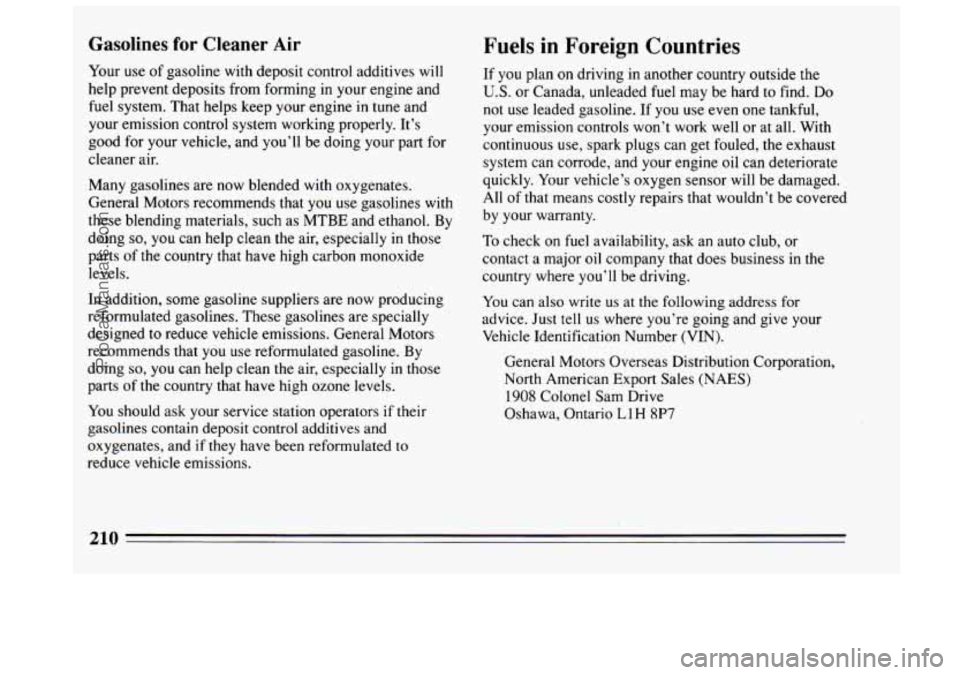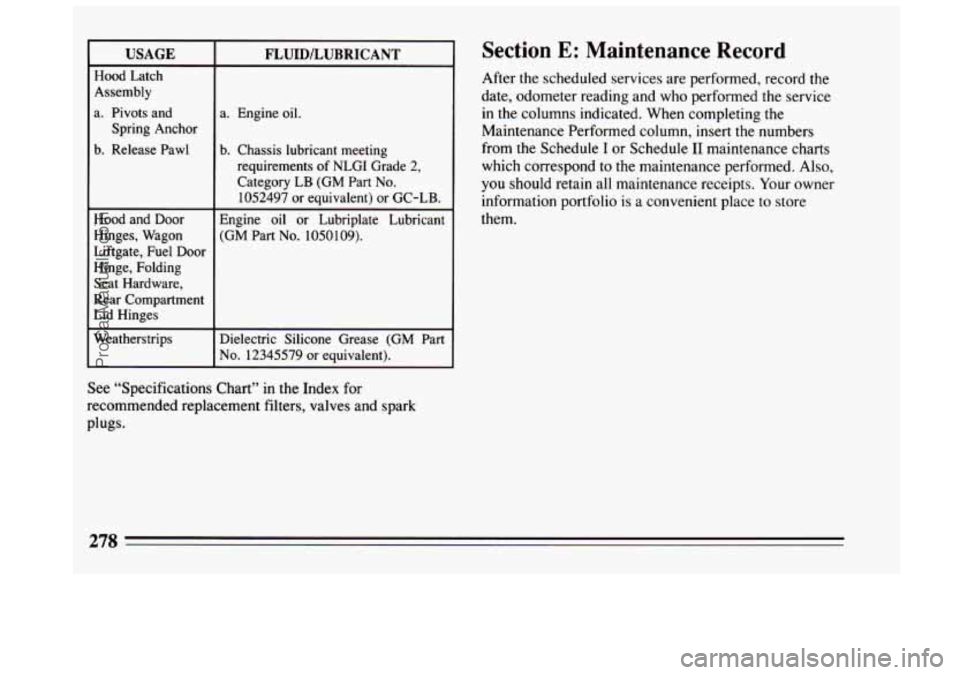spark plugs BUICK CENTURY 1994 Owners Manual
[x] Cancel search | Manufacturer: BUICK, Model Year: 1994, Model line: CENTURY, Model: BUICK CENTURY 1994Pages: 308, PDF Size: 16.3 MB
Page 212 of 308

Gasolines for Cleaner Air
Your use of gasoline with deposit control additives will
help prevent deposits from forming in your engine and
fuel system. That helps keep your engine in tune and
your emission control system working properly. It’s
good for your vehicle, and you’ll be doing your part for
cleaner air.
Many gasolines are now blended with oxygenates.
General Motors recommends that you use gasolines with
these blending materials, such as MTBE and ethanol. By
doing
so, you can help clean the air, especially in those
parts of the country that have high carbon monoxide
levels.
In addition, some gasoline suppliers are now producing
reformulated gasolines. These gasolines are specially
designed to reduce vehicle emissions. General Motors
recommends that you use reformulated gasoline. By
doing
so, you can help clean the air, especially in those
parts of the country that have high ozone levels.
You should ask your service station operators if their
gasolines contain deposit control additives and
oxygenates, and if
they have been reformulated to
reduce vehicle emissions.
Fuels in Foreign Countries
If you plan on driving in another country outside the
U.S. or Canada, unleaded fuel may be hard to find. Do
not use leaded gasoline. If you use even one tankful,
your emission controls won’t work well or at all. With
continuous use, spark plugs can get fouled, the exhaust
system can corrode, and your engine oil can deteriorate
quickly. Your vehicle’s oxygen sensor will be damaged.
All of that means
costly repairs that wouldn’t be covered
by your warranty.
To check on fuel availability, ask an auto club, or
contact a major oil company that does business in the
country where you’ll be driving.
You can also write
us at the following address for
advice. Just tell us where you’re going and give your
Vehicle Identification Number (VIN).
General Motors Overseas Distribution Corporation,
North American Export Sales (NAES)
1908 Colonel Sam Drive
Oshawa, Ontario
L1H 8P7
210
ProCarManuals.com
Page 273 of 308

6. ’Ikande Service -- Change both the fluid and filter
every 15,000 miles
(25 0oO km) if the vehicle is
mainly driven under one or more of these conditions:
In heavy city traffic where the outside
temperature regularly reaches
90°F (32 “C) or
higher.
0 In hilly or mountainous terrain.
0 When doing frequent trailer towing.
Uses such as found in taxi, police car or delivery
service.
9. Exhaust Gas Recirculation (EGR) System
Inspection
(2.2 L Code 4 engine only) *? ---
Conduct the EGR system service as described in the
service manual.
To purchase a service manual, see
“Service Publications” in the Index.
10. Air Cleaner Filter Replacement* -- Replace every
30,000 miles (50 0o0 km) or more often under dusty
conditions. Ask your dealer for the proper
replacement intervals for your driving conditions.
11.
Fuel Tank, Cap and Lines Inspection*? -- Inspect
fuel
tank, cap and lines for damage or leaks. Inspect
fuel cap gasket for an even filler neck imprint
or any
damage. Replace parts as needed. Periodic replacement
of the fuel filter is not required.
If you
do not use your vehicle under any of these
conditions, change both the fluid and filter every 100,OOO miles (160 OOO km).
7. Spark Plug Replacement* -- Replace spark plugs
with the proper type. See “Specifications Chart”
in
the Index.
8. Spark Plug Wire Inspection*’f’ -- Inspect for bums,
cracks or other damage. Check the boot fit at the
distributor and at the spark plugs. Replace wires as
needed.
* An Emission Control Service.
The
U.S. Environmental Protection Agency or the California Air Resources Board has determined that the fail\
ure to perform this maintenance item will not nullify the
emission warranty or limit recall liability prior to the completion of vehicle useful life. General Motors, however, urges that all recommended maintenance services be performed at the indicated intervals and the maintenance be recorded in “Section E:Maintenance Record”.
271
ProCarManuals.com
Page 280 of 308

USAGE
Hood Latch
Assembly
a. Pivots and
b. Release Pawl
Spring
Anchor
Hood and
Door
Hinges, Wagon
Liftgate, Fuel Door
Hinge, Folding
Seat Hardware,
Rear Compartment
Lid Hinges
Weatherstrips
FLUID/LUBRICANT I
a. Engine oil.
b. Chassis lubricant meeting
requirements of NLGI Grade
2,
Category LB (GM Part No.
1052497 or equivalent) or GC-LB.
Engine oil or Lubriplate Lubricant
(GM Part
No. 1050109).
Dielectric Silicone Grease
(GM Part
No. 12345579 or equivalent).
See “Specifications Chart” in the Index for
recommended replacement filters, valves and spark
plugs.
Section E: Maintenance Record
After the scheduled services are performed, record the
date, odometer reading and who performed the service
in the columns indicated. When completing the
Maintenance Performed column, insert the numbers
from the Schedule
I or Schedule I1 maintenance charts
which correspond
to the maintenance performed. Also,
you should retain all maintenance receipts. Your owner
information portfolio is a convenient place to store
them.
ProCarManuals.com